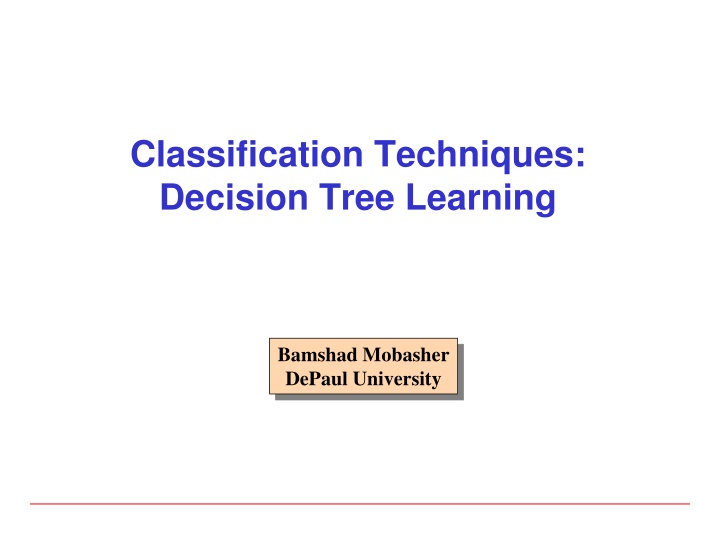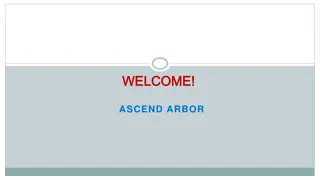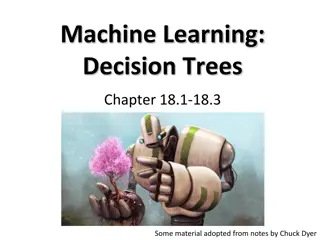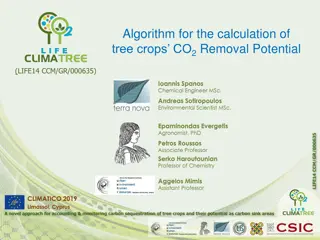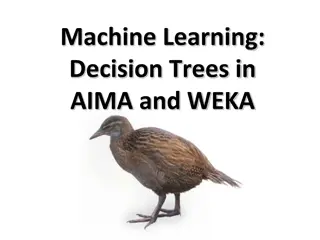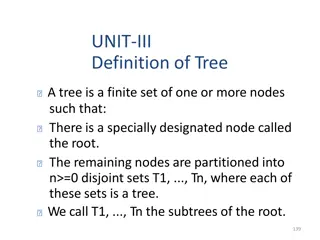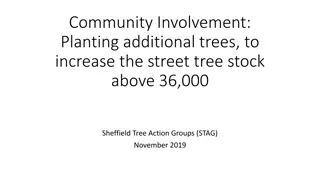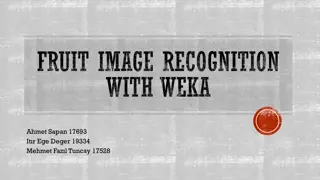Introduction to Decision Tree Classification Techniques
Decision tree learning is a fundamental classification method involving a 3-step process: model construction, evaluation, and use. This method uses a flow-chart-like tree structure to classify instances based on attribute tests and outcomes to determine class labels. Various classification methods, such as Bayesian classification and neural networks, complement decision trees in data analysis for predicting outcomes accurately.
Download Presentation

Please find below an Image/Link to download the presentation.
The content on the website is provided AS IS for your information and personal use only. It may not be sold, licensed, or shared on other websites without obtaining consent from the author.If you encounter any issues during the download, it is possible that the publisher has removed the file from their server.
You are allowed to download the files provided on this website for personal or commercial use, subject to the condition that they are used lawfully. All files are the property of their respective owners.
The content on the website is provided AS IS for your information and personal use only. It may not be sold, licensed, or shared on other websites without obtaining consent from the author.
E N D
Presentation Transcript
Classification Techniques: Decision Tree Learning Bamshad Mobasher DePaul University
Classification: 3 Step Process 1. Model construction (Learning): Each record (instance, example) is assumed to belong to a predefined class, as determined by one of the attributes This attribute is called the target attribute The values of the target attribute are the class labels The set of all instances used for learning the model is called training set 2. Model Evaluation (Accuracy): Estimate accuracy rate of the model based on a test set The known labels of test instances are compared with the predicts class from model Test set is independent of training set otherwise over-fitting will occur 3. Model Use (Classification): The model is used to classify unseen instances (i.e., to predict the class labels for new unclassified instances) Predict the value of an actual attribute 2
Classification Methods Decision Tree Induction Bayesian Classification K-Nearest Neighbor Neural Networks Support Vector Machines Association-Based Classification Genetic Algorithms Many More . Also Ensemble Methods 3
Decision Trees A decision tree is a flow-chart-like tree structure Internal node denotes a test on an attribute (feature) Branch represents an outcome of the test All records in a branch have the same value for the tested attribute Leaf node represents class label or class label distribution outlook sunny overcast rain windy humidity P normal high true false P N N P 4
Instance Language for Classification Example: is it a good day to play golf? a set of attributes and their possible values: outlook temperature humidity windy A particular instance in the training set might be: sunny, overcast, rain cool, mild, hot high, normal true, false <overcast, hot, normal, false>: play In this case, the target class is a binary attribute, so each instance represents a positive or a negative example. 5
Using Decision Trees for Classification Examples can be classified as follows 1. look at the example's value for the feature specified 2. move along the edge labeled with this value 3. if you reach a leaf, return the label of the leaf 4. otherwise, repeat from step 1 Example (a decision tree to decide whether to go on a picnic): outlook So a new instance: sunny overcast rain <rainy, hot, normal, true>: ? will be classified as noplay humidity windy P high normal true false N N P P 6
Decision Trees and Decision Rules outlook If attributes are continuous, internal nodes may test against a threshold. overcast rain sunny humidity windy P > 75%<= 75% > 20 <= 20 P N N P Each path in the tree represents a decision rule: Rule1: If (outlook= sunny ) AND (humidity<=0.75) Then (play= yes ) Rule3: If (outlook= overcast ) Then (play= yes ) . . . Rule2: If (outlook= rainy ) AND (wind>20) Then (play= no ) 7
Top-Down Decision Tree Generation The basic approach usually consists of two phases: Tree construction At the start, all the training instances are at the root Partition instances recursively based on selected attributes Tree pruning (to improve accuracy) remove tree branches that may reflect noise in the training data and lead to errors when classifying test data Basic Steps in Decision Tree Construction Tree starts a single node representing all data If instances are all same class then node becomes a leaf labeled with class label Otherwise, select featurethat best distinguishes among instances Partition the data based the values of the selected feature (with each branch representing one partitions) Recursion stops when: instances in node belong to the same class (or if too few instances remain) There are no remaining attributes on which to split 8
Trees Construction Algorithm (ID3) Decision Tree Learning Method (ID3) Input: a set of training instances S, a set of features F 1. If every element of S has a class value yes , return yes ; if every element of S has class value no , return no 2. Otherwise, choose the best feature f from F (if there are no features remaining, then return failure); 3. Extend tree from f by adding a new branch for each attribute value of f 3.1. Set F = F {f}, 4. Distribute training instances to leaf nodes (so each leaf node n represents the subset of examples Sn of S with the corresponding attribute value 5. Repeat steps 1-5 for each leaf node n with Sn as the new set of training instances and F as the new set of attributes Main Question: how do we choose the best feature at each step? Note: ID3 algorithm only deals with categorical attributes, but can be extended (as in C4.5) to handle continuous attributes 9
Choosing the Best Feature Use Information Gain to find the best (most discriminating) feature Assume there are two classes, P and N (e.g, P = yes and N = no ) Let the set of instances S (training data) contains p elements of class P and n elements of class N The amount of information, needed to decide if an arbitrary example in S belongs to P or N is defined in terms of entropy, I(p,n): = Pr( )log Pr( ) Pr( )log Pr( ) P P ( , ) I p n N N 2 2 Note that Pr(P) = p / (p+n) and Pr(N) = n / (p+n) In other words, entropy of a set on instances S is a function of the probability distribution of classes among the instances in S. 10
Entropy Entropy for a two class variable 11
Entropy in Multi-Class Problems More generally, if we have m classes, c1, c2, , cm, with s1, s2, , sm as the numbers of instances from S in each class, then the entropy is: ???log2 ?? I ?1,?2, ,?? = ?=1 where pi is the probability that an arbitrary instance belongs to the class ci. 12
Information Gain Now, assume that using attribute A a set S of instances will be partitioned into sets S1, S2 , , Sv each corresponding to distinct values of attribute A. If Si contains picases of P and ni cases of N, the entropy, or the expected information needed to classify objects in all subtrees Si is The probability that an arbitrary instance in S belongs to the partition Si + S S p p n + n = = = i ( ) E A Pr( ) ( , ) i S I p n Pr( ) i i S where, i i i = 1 i The encoding information that would be gained by branching on A: = ( ) ( , ) ( ) Gain A I p n E A At any point we want to branch using an attribute that provides the highest information gain. 13
Attribute Selection - Example The Golf example: what attribute should we choose as the root? S: [9+,5-] Day outlook D1 D2 D3 overcast D4 D5 D6 D7 overcast D8 D9 D10 D11 D12 overcast D13 overcast D14 temp hot hot hot mild cool cool cool mild cool mild mild mild hot mild humidity high high high high normal normal normal high normal normal normal high normal high wind weak strong weak weak weak strong strong weak weak weak strong strong weak strong play No No Yes Yes Yes No Yes No Yes Yes Yes Yes Yes No sunny sunny Outlook? overcast rainy rain rain rain sunny [3+,2-] [2+,3-] [4+,0-] sunny sunny rain sunny I(9,5) = -(9/14).log(9/14) - (5/14).log(5/14) = 0.94 I(4,0) = -(4/4).log(4/4) - (0/4).log(0/4) = 0 rain I(2,3) = -(2/5).log(2/5) - (3/5).log(3/5) = 0.97 Gain(outlook) = .94 - (4/14)*0 - (5/14)*.97 - (5/14)*.97 = .24 I(3,2) = -(3/5).log(3/5) - (2/5).log(2/5) = 0.97 14
Attribute Selection - Example (Cont.) Day outlook D1 D2 D3 overcast D4 D5 D6 D7 overcast D8 D9 D10 D11 D12 overcast D13 overcast D14 temp hot hot hot mild cool cool cool mild cool mild mild mild hot mild humidity high high high high normal normal normal high normal normal normal high normal high wind weak strong weak weak weak strong strong weak weak weak strong strong weak strong play No No Yes Yes Yes No Yes No Yes Yes Yes Yes Yes No S: [9+,5-] (I = 0.940) sunny sunny humidity? high normal rain rain rain [6+,1-] (I = 0.592) [3+,4-] (I = 0.985) sunny sunny rain sunny Gain(humidity) = .940 - (7/14)*.985 - (7/14)*.592 = .151 S: [9+,5-] (I = 0.940) wind? rain strong weak So, classifying examples by humidity provides more information gain than by wind. Similarly, we must find the information gain for temp . In this case, however, you can verify that outlook has largest information gain, so it ll be selected as root [3+,3-] (I = 1.00) [6+,2-] (I = 0.811) Gain(wind) = .940 - (8/14)*.811 - (8/14)*1.0 = .048 15
Attribute Selection - Example (Cont.) Partially learned decision tree S: [9+,5-] {D1, D2, , D14} Outlook sunny overcast rainy ? yes ? [2+,3-] [3+,2-] [4+,0-] {D1, D2, D8, D9, D11} {D4, D5, D6, D10, D14} {D3, D7, D12, D13} which attribute should be tested here? Ssunny = {D1, D2, D8, D9, D11} Gain(Ssunny, humidity) = .970 - (3/5)*0.0 - (2/5)*0.0 = .970 Gain(Ssunny, temp) = .970 - (2/5)*0.0 - (2/5)*1.0 - (1/5)*0.0 = .570 Gain(Ssunny, wind) = .970 - (2/5)*1.0 - (3/5)*.918 = .019 16
Other Attribute Selection Measures Gain ratio: Information Gain measure tends to be biased in favor attributes with a large number of values Gain Ratio normalizes the Information Gain with respect to the total entropy of all splits based on values of an attribute Used by C4.5 (the successor of ID3) But, tends to prefer unbalanced splits (one partition much smaller than others) Gini index: A measure of impurity (based on relative frequencies of classes in a set of instances) The attribute that provides the smallest Gini index (or the largest reduction in impurity due to the split) is chosen to split the node Possible Problems: Biased towards multivalued attributes; similar to Info. Gain. Has difficulty when # of classes is large 17
Overfitting and Tree Pruning Overfitting: An induced tree may overfit the training data Too many branches, some may reflect anomalies due to noise or outliers Some splits or leaf nodes may be the result of decision based on very few instances, resulting in poor accuracy for unseen instances Two approaches to avoid overfitting Prepruning: Halt tree construction early do not split a node if this would result in the error rate going above a pre-specified threshold Difficult to choose an appropriate threshold Postpruning: Remove branches from a fully grown tree Get a sequence of progressively pruned trees Use a test data different from the training data to measure error rates Select the best pruned tree 18
Enhancements to Basic Decision Tree Learning Approach Allow for continuous-valued attributes Dynamically define new discrete-valued attributes that partition the continuous attribute value into a discrete set of intervals Handle missing attribute values Assign the most common value of the attribute Assign probability to each of the possible values Attribute construction Create new attributes based on existing ones that are sparsely represented This reduces fragmentation, repetition, and replication 19
Classification Techniques: Decision Tree Learning Bamshad Mobasher DePaul University
